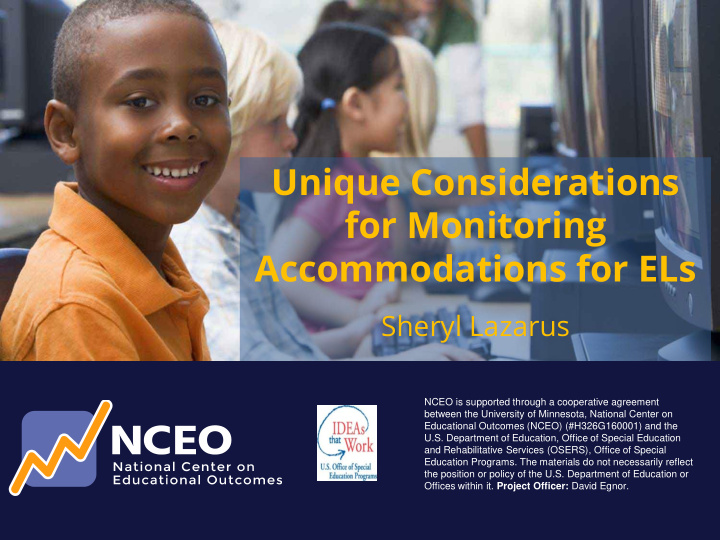



Unique Considerations for Monitoring Accommodations for ELs Sheryl Lazarus NCEO is supported through a cooperative agreement between the University of Minnesota, National Center on Educational Outcomes (NCEO) (#H326G160001) and the U.S. Department of Education, Office of Special Education and Rehabilitative Services (OSERS), Office of Special Education Programs. The materials do not necessarily reflect the position or policy of the U.S. Department of Education or Offices within it. Project Officer: David Egnor.
Characteristics of ELS • 9.4% of students were English learners during the 2014-15 school year, with a range from 1% in the state with the lowest percentage of ELs to 22% in the state with the highest percentage. • Top-four home languages: Spanish, Arabic, Chinese, Vietnamese (NCES)
Assessments and ELs • Take both content assessments and English language proficiency (ELP) assessments. (Students who have not been in the country a full year do not have to take the ELA/reading assessment.) • When monitoring, the issues are the same for content assessments and ELP assessments.
What ESSA says Section 1111(b)(2)(B)(vii) provide for — (I) the participation in such assessments of all students; (II) the appropriate accommodations, such as interoperability with, and ability to use, assistive technology, for children with disabilities . . . and (III) the inclusion of English learners, who shall be assessed in a valid and reliable manner and provided appropriate accommodations on assessments administered to such students under this paragraph, including, to the extent practicable, assessments in the language and form most likely to yield accurate data on what such students know and can do in academic content areas, until such students have achieved English language proficiency….
Unique Issues • May not always be clear which office will monitor accommodations for ELs. • Students with disabilities have a discrete paper trail; not really as clear with ELs.
EL Plans • EL plans are not required by federal legislation. • Not every state has a systematic planning process for ELs.
ELs with Disabilities • Special education accommodations provided through IEP, but does not necessarily cover linguistic accommodations.
Some states have the foundations in place to build on – especially if online • Personal needs profile indicates which accommodations students are supposed to receive • But often can not tell which accommodations students actually receive – but this then shifts to the same issues as for all monitoring of accommodations (observation, etc.).
Tiers of Accessibility Tiers of Accessibility Universal Features for all students Designated Features for students who need them as identified by an educator in advance Accommodations for students with disabilities; in some cases, ELs are also eligible • Many things that were once called accommodations are now called designated features. • Monitoring across tiers is the same for students with disabilities and ELs. • Regardless of what they are called, best practice is to monitor both designated features and accommodations.
Consortia/States Differ in How Provide Accessibility to ELs • Content Assessments − PARCC’s policy includes accommodations for ELs. − Smarter Balanced does not have accommodations for ELs; everything is considered a designated feature (e.g., designated support). • ELP Assessments – WIDA and ELPA21 have designated features for ELs; accommodations available for ELs with disabilities.
Wide variation across states in polices • Some states English only states – less likely to have staked translations, etc. • How should accommodations be monitored in English only states?
Home Language • May be challenging to ensure accessibility for students whose home language is a less frequent one in a state.
What it Says in ESSA about Instruction • Ensuring the provision of appropriate accommodations available to English learners and children with disabilities to improve the rates of inclusion in regular assessments of such children, including professional development activities to improve the implementation of such accommodations in instructional practice (Part B, Sec. 1201, (a)(2)(A)) • States must ensure that English learners are included in academic instruction and statewide assessments by providing appropriate accommodations to all English learners. (ESSA Assessment Regulations)
Underlying Challenges: Language is an Issue • Many EL educators do not perceive that they are providing accommodations during instruction. • In instruction, educators refer to supports, etc. • Then often fail to see the relationship between instructional supports and assessment accommodations.
Strategies • Work with other SEA agencies to develop policies for the accessibility and accommodations decision-making process for ELs, including how accommodations should be documented. • If state (or district) requires EL plan, use it as the basis for monitoring. • Collect and analyze data • Review accessibility and accommodations policies; revise as needed. • Provide professional development to educators on accessibility and accommodations decision making for both instruction and assessment.
For More Information www.nceo.info Sheryl Lazarus laza0019@umn.edu
Recommend
More recommend